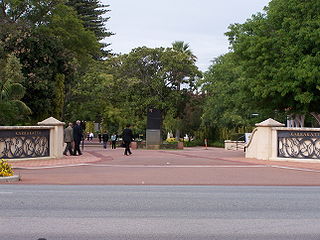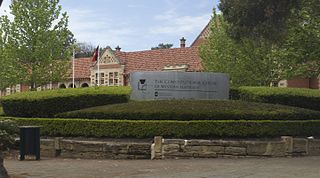
Edith Dircksey Cowan was an Australian social reformer who worked for the rights and welfare of women and children. She is best known as the first Australian woman to serve as a member of parliament. Cowan has been featured on the reverse of Australia's 50-dollar note since 1995.

Edith Cowan University (ECU) is a public university in Perth, Australia. It is named in honour of the first woman to be elected to an Australian parliament, Edith Cowan, and is the only Australian university named after a woman. Gaining university status in 1991, it was formed from an amalgamation of tertiary colleges with a history dating back to 1902 when the Claremont Teachers College was established, making it the modern descendant of the first tertiary institution in Western Australia.

The Anzac Memorial is a heritage-listed war memorial, museum and monument located in Hyde Park South near Liverpool Street in the CBD of Sydney, Australia. It is also known as Anzac War Memorial, War Memorial Hyde Park and Hyde Park Memorial. The Art Deco monument was designed by C. Bruce Dellit, with the exterior adorned with monumental figural reliefs and sculptures by Rayner Hoff, and built from 1932 to 1934 by Kell & Rigby. This state-owned property was added to the New South Wales State Heritage Register on 23 April 2010.

Kings Park, is a 400.6-hectare (990-acre) park overlooking Perth Water and the central business district of Perth, Western Australia.

Karrakatta Cemetery is a metropolitan cemetery in the suburb of Karrakatta in Perth, Western Australia. Karrakatta Cemetery first opened for burials in 1899, the first being that of wheelwright Robert Creighton. Managed by the Metropolitan Cemeteries Board, the cemetery attracts more than one million visitors each year. Cypress trees located near the main entrance are a hallmark of Karrakatta Cemetery. The cemetery contains a crematorium, and in 1995 Western Australia's first mausoleum opened at the site.

West Perth is an inner suburb of Perth, the capital city of Western Australia.
The Women's Service Guilds (WSG), initially known as the Women's Service Guilds of Western Australia, was an organising body of the feminist movement in Australia. Founded in 1909, they integrated the campaigns for improved status and welfare of women and children nationally and with overseas organisations.
Harold Boas was a town planner and architect in Western Australia. Boas designed many public buildings in and around Perth and was an influential Jewish community leader. He served as an elected member of the Perth City Council on three separate occasions, presided over the Metropolitan Town Planning Commission and was the foundation president of the Town Planning Institute of Western Australia.
Harry C. J. Phillips,, , is a leading political and civic education advocate and political commentator in Western Australia. He has extensive teaching and lecturing experience in primary, secondary and tertiary institutions in political and civic education and has published widely in these fields, as well as sport, particularly tennis. Phillips's commitment to civics stems from his youth at Hyden Primary School, and his Alma Mater, Hale School.

The Karrakatta Club is a women's club in Perth, Western Australia. Established in 1894, it was the first women's club in Australia.
William George Pickering was an Australian politician. He was the Country Party member for Sussex in the Western Australian Legislative Assembly from 1917 to 1924. In 1920, he was the only member of the Legislative Assembly to vote against allowing women to stand for parliament.

The Fremantle War Memorial is a war memorial located on Monument Hill, an 11-acre (4.45-hectare) public reserve and hill in Fremantle, Western Australia. The memorial itself comprises a large obelisk, the Fallen Soldiers' and Sailors' Memorial, surrounded by eight smaller memorials. The site, located on High Street near the centre of Fremantle, overlooks Fremantle Harbour, and was established by the Fremantle Town Council in 1928 to commemorate the losses of the First World War, having been used as a public reserve since the early 19th century.
Lyla Daphne Elliott was an Australian politician who was a Labor member of the Legislative Council of Western Australia between 1971 and 1986, representing North-East Metropolitan Province.

Cairns War Memorial is a heritage-listed memorial at The Esplanade, Cairns City, Cairns, Cairns Region, Queensland, Australia. It was built in 1925. It was added to the Queensland Heritage Register on 21 October 1992.

Thomas Percy Draper CBE KC was an Australian lawyer, politician, and judge. He was a member of the Legislative Assembly of Western Australia from 1907 to 1911 and again from 1917 to 1921, and was attorney-general in the first government of Sir James Mitchell. He later served on the Supreme Court of Western Australia from 1921 to 1939.

King's Park Road is situated in West Perth in Western Australia. It was once known as Brooking Street. It runs as a boundary between the suburbs of West Perth and Kings Park, from the west end of Malcolm Street to the corner of Bagot Road, Subiaco and Thomas Street, West Perth.
Margaret G. Johnson, was a Sri Lankan born Australian portrait artist.

Portia Stranston Geach was an Australian artist and feminist. She was a founder and a president of the New South Wales Housewives' Association, as well as a president of the Federal Association of Australian Housewives. The Portia Geach Memorial Award, established by a legacy from Geach's sister, is Australia's most significant prize for Australian female portrait artists.
Edith Dircksey Brown Cowan (1861–1932) was an Australian social reformer.















